White Spots on Teeth: Early Cavity Warning or Something Else?
Have white spots developing on your teeth been causing you to panic? They could be due to tooth decay, poor diet, demineralization, disease, or fluoride deficiency.
White spots on teeth don’t appear overnight, but when they develop, it’s usually due to a significant issue. White spots mean that the enamel has been damaged. However, the enamel is the hardest layer of the tooth and is capable of withstanding damage.
This blog explores the causes of enamel damage. It also covers the dental procedures and methods 65 Broadway Dental uses to treat white spots on teeth.
What is the White Stuff On Teeth Near Gums?
If you’ve looked at your teeth in the mirror lately, you may have noticed white stuff. It appears as a white accumulation where your tooth and gums meet.
These white appearances can be present on the teeth themselves or on the gums. The reasons for both are different, and solving them can take varying treatments.
Knowing what it is and why it’s collecting can help you stop it. The white stuff can affect your smile and appearance. Besides, if it’s also causing pain or bleeding gums, it could be one of the warning signs of gum disease.
What Causes White Spot Lesions on Teeth?
White spot lesions are white areas that appear on the tooth’s surface. They start from all the edges of the teeth and spread inwards. When the case worsens, the tooth can be compromised. If decay has been occurring for a long time, only cosmetic dentistry can rescue your teeth.
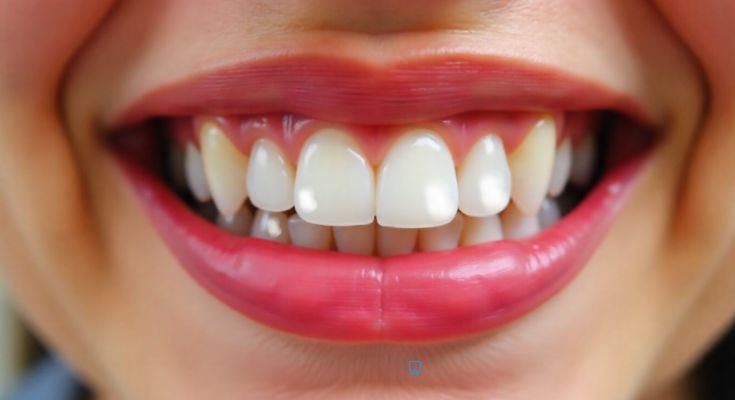
The white accumulation could be a sign of a condition or disease developing gradually. It could also signal bad habits and a poor diet. Here are the four common causes of white stuff or white spot lesions on teeth.
1. Plaque
Plaque is the substance that eventually turns into the hard tartar accumulations. Plaque first forms a sticky, thin layer made up of bacteria and acids.
Without treatment, it collects, hardens, and turns into a yellowish-white substance called tartar. Tartar buildup is dangerous, leading to tooth decay and, in severe cases, demineralization.
2. Food Debris
Eating a poor selection of foods can lead to the accumulation of white substance on teeth. This mostly occurs when eating certain foods. Starchy snacks like chips, wafers, or glutenous breads are the biggest culprits.
Food sticking to teeth is a common problem among elderly people. The fact that tooth decay accelerates in people over 60 makes them more vulnerable to oral issues.
3. Medications
Occasionally, white spots on teeth can arise from the use of certain medications. These medicines make the teeth more vulnerable to external factors. They either damage the tooth’s enamel or cause oral conditions that favor bacterial growth.
The medicines known to cause these issues include antidepressants, certain antibiotics, Parkinson’s disease, and blood pressure medication.
4. Poor Oral Hygiene
Good oral hygiene is a collection of steps. When done properly and regularly, it protects the mouth, teeth, and gums.
However, straying from this routine for long will have dire effects. Poor oral care accelerates tooth decay, and white deposits mean it’s happening. Without oral hygiene, tartar will build up gradually.
5. Demineralization
This natural process of enamel mineral loss happens to everyone. It doesn’t become a problem until the lost minerals aren’t replaced.
To solve it, you’ll need to replace vital minerals and nutrients. These include key dental health contributing components like:
- Calcium
- Fluoride
- Vitamin D
Reducing sugary foods will also contribute to enamel regeneration. This will require parents’ cooperation due to the high amounts of hidden sugar in healthy kids’ food.
What are White Spots on the Gums or Tongue?
White spots or patches don’t only form on the teeth. They can even form on the gums or tongue! The reasons for this differ from those causing them to form on teeth, have a look.
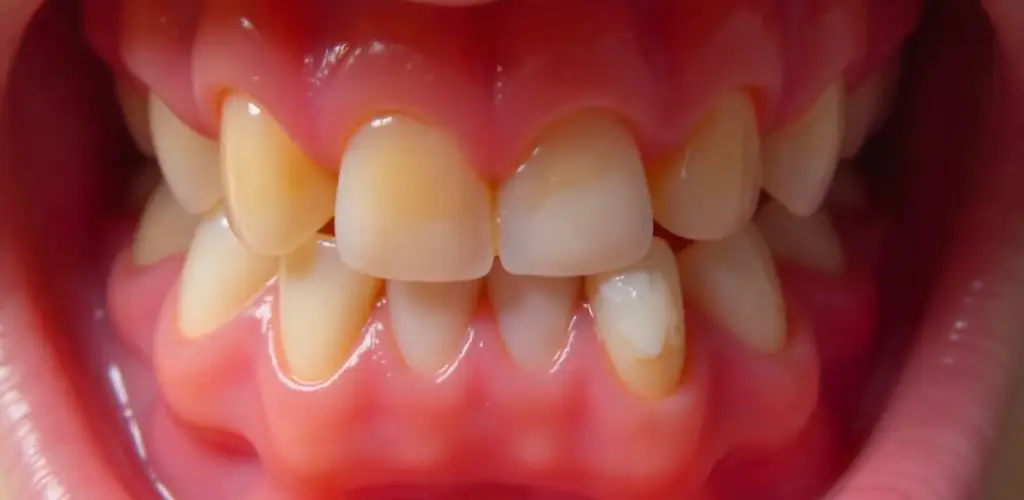
1. Leuoplakia
This condition causes a white film to grow over the inside of the mouth. It affects the inside of the cheeks and the bottom of the mouth.
Irritating the gum tissues can lead to leuoplakia. The following instances are risk factors for developing leuoplakia:
- Braces or poorly fitting dentures are common instances where the oral tissues can be irritated.
- Smoking and using tobacco products can also cause this issue.
- Excessive alcohol consumption.
- Immune-system-compromising diseases like HIV or Epstein-Barr.
Catching this condition and treating it quickly is crucial. If left untreated for long, leuoplakia can become cancerous.
Your dental healthcare provider can conduct a biopsy to determine if it’s cancerous.
2. Oral Thrush
Oral thrush, also known as oral candidiasis, appears as a white film over the tongue. It’s caused by a fungus called Candida albicans.
There are many causes behind oral thrush, including these:
- Stress
- Antibiotics
- Steroids
- HIV/AIDS
- Birth Control Pills
Thrush is treated with antifungal medications. They come in tablet, lozenge, and liquid forms to ensure maximum exposure to affected areas. Your healthcare provider could insist you continue the medication for at least 10 to 14 days.
Good oral care, regular dentist visits, limiting yeast-containing foods, and avoiding alcohol are prevention methods.
3. Canker Sores
Everyone has had a canker sore before; that’s how common they are. They’re those mouth ulcers that have a white center surrounded by a red outer ring.
If you don’t remember their appearance, the pain is sure to remind you of them. They are a major cause of discomfort, making it difficult to eat or drink properly.
These sores may cause pain, but heal on their own within a few weeks. The reasons for these sores range, but these are the most common of them:
- Stress
- Trauma
- Certain Foods
Canker sores are also one of the causes of bleeding gums in adults. Canker sores aren’t usually a cause for concern due to their self-healing nature. But if they don’t heal after weeks, you may need to visit a dentist for medical attention.
4. Anemia
Anemia is a condition in which the body lacks enough healthy red blood cells. The core function of these cells is to transport oxygen throughout the body.
Without enough oxygen, the skin becomes pale and concerning. A lack of oxygen in the gum tissue can cause the gums to become white. This color change of the gums can also occur due to nutrient and mineral deficiencies.
Shortages of Iron, Vitamin B12, or folic acid can also cause the gums to change color.
Are White Spots on Teeth Permanent?
In most cases, if caught early enough, they are temporary and can be treated. However, if they are caught late and too much damage has been caused, they could be permanent.
Neglecting white spots for years and years could make them permanent. Even worse, you could lose your permanent teeth. If the decay has gotten to the tooth’s roots, you could need a surgical extraction.
For small white spots, several cosmetic procedures are available to remove them. Knowing if the white spots are removable or not requires a dentist. Your dentist will need to conduct an oral exam to make the assessment.
How To Remove White Spots On Teeth Naturally
Try these techniques to get rid of or fade white spots on your teeth.
“You can’t brush white spots away, but you can help your teeth heal themselves. Remineralizing treatments and foods rich in Calcium and Phosphorus help to restore enamel in lesions.”
— Dr. Alexander Heifitz, founder of 65 Broadway Dental NYC
1. Oil Pulling
This technique is from the Indian traditional medicine system, Ayurveda. It enables you to stop white spots by preventing tooth decay.
It involves swishing oil in the mouth for between 5 and 10 minutes. The type of oil could be sesame, coconut, or sunflower oil. The oil comes into contact with the bacteria’s wall, and it naturally sticks to it.
2. Occasional Baking Soda Rinse
Baking soda is an ingredient that helps teeth. It’s a natural teeth whitener and has abrasive properties. Over time, rinsing or brushing with baking soda can help change the appearance of teeth.
Toothpastes with baking soda also help to whiten teeth and make the spots less visible.
3. Remineralization Toothpaste
If you have white spots on your teeth due to demineralization, a remineralization toothpaste can help. These toothpastes come embedded with Calcium, Phosphate, or Hydroxyapatite.
These three minerals are known to cause white spots on teeth when they are in short supply. Remineralization helps to remove the contrasting appearance between the white spots and the surrounding tooth.
4. Adjust Diet
Dietary adjustments are another way people can naturally help their teeth improve. Foods like cheese, milk, yogurt, and leafy greens contain calcium and phosphorus. These minerals will promote the repair of damaged enamel.
Apart from providing crucial minerals, these foods also alter the environment in the mouth, making it less sugar-rich and acidic.
5. Hydrogen Peroxide
This is a chemical with natural bleaching and bacteria-killing qualities. No wonder it’s a common ingredient in teeth-whitening products.
However, using it too frequently or in high concentrations can cause gum irritation and tooth sensitivity.
How to Prevent the Formation of White Spots on Teeth?
White spots on teeth could develop unexpectedly if care and attention aren’t paid. If you take extra care, you could prevent the chances of getting them. Here’s what you can do to reduce your vulnerability to white spots:
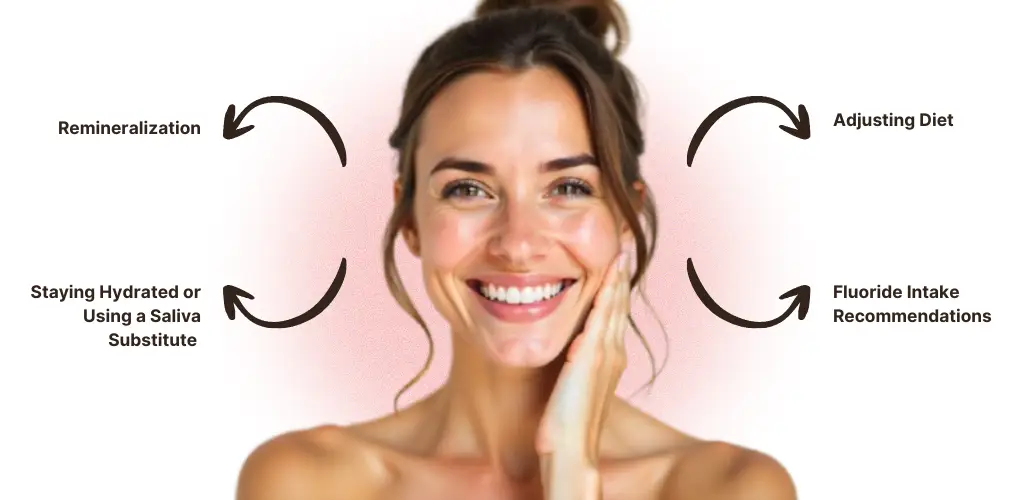
Remineralization
The process of teeth remineralization works to repair teeth, more specifically, the outer enamel. Protecting or restoring the enamel is critical because it’s the tooth’s main defence.
In remineralization, minerals like calcium and phosphate are deposited onto the teeth from the saliva. This action helps combat mineral loss that occurs during the natural process of demineralization.
Staying Hydrated or Using a Saliva Substitute
A lack of saliva can cause white spots on teeth. Ensuring adequate saliva production is vital to avoid this from happening.
If you’re suffering from dry mouth, try some of the 15 natural solutions for dry mouth. Alternatively, a quicker solution is to use saliva substitutes that mimic the function of saliva.
Adjusting Diet
Diet is another deciding factor in oral health. Bad foods can be damaging, so try to limit foods with too much sugar, starch, and carbohydrates.
Try to incorporate fresh fruits, vegetables, nuts, and dairy products into your diet. These items ensure teeth develop properly and you receive the necessary nutrients to repair them.
Following Fluoride Intake Recommendations
The CDC’s advisory on Fluoride shows how vital fluoridated water is in communities. This is especially true for children aged between 6 months and 16 years.
If you don’t have access to fluoridated water, consider asking your dentist to suggest a supplement. Some fluoride supplements are for children, while others are for adults. It’s vital to follow the amounts prescribed by the dentist or doctor.
How Can a Dentist Treat White Spots on Teeth?
If the damage isn’t irreversible, the following dental procedures can help you hide it. Depending on severity and expected results,
1. Fluoride Treatments
These treatments are helpful when the teeth haven’t developed properly. It’s also beneficial when fluoride quantities are low or there’s potential for damaged enamel to heal.
Fluoride treatments are helpful when adequate amounts of fluoride are absent in water and toothpaste.
2. Dental Cleaning
Frequent professional dental cleaning will remove plaque and prevent it from hardening. These cleanings are usually conducted twice a year. However, people who are more prone to plaque buildup or white spots on teeth should go more frequently.
If you haven’t been to a dental cleaning and are unsure what to expect, we can help. Read our blog on: What Happens During a Dental Cleaning?
3. Teeth Whitening
Whitening your teeth may not remove the white spots, but it makes them blend in. By doing this procedure, people won’t notice the spots so much.
Teeth whitening will make the teeth look more appealing, synchronizing the color throughout. This procedure is one of the most popular dental treatments, proving that it works!
4. Porcelain Veneers
When the damage is permanent, people turn to other cosmetic solutions. That said, even if they are a bit invasive!
Porcelain veneers are thin coverings that are fixed onto the surface of the teeth. To keep the veneers on the teeth, dentists will shave the top enamel.
If you’re refreshing your smile and considering veneers and other options, read our comparison: Veneers vs Bonding in NYC: Which One Is Right for You?
5. ICON
The ICON treatment is specially designed to treat early signs of tooth decay and remove white marks. The modern, pain-free, and non-surgical qualities of this treatment make it suitable for kids and teenagers with braces.
In the ICON procedure, dentists use a resin to fill micro-cavities. Although applied outside, it can travel inside the tooth and seal the hole from the inside out. It also helps to remove discoloration.
The fact that this procedure is for kids is a relief for parents. This especially applies to those who are always looking for better treatments for kids’ cavities.
6. Microabrasion
This technique of removing white spots requires rubbing the enamel with an abrasive solution. It’s usually used with the ICON procedure, with Microabrasion being the first step.
Repeated microabrasion may be necessary to get the desired approach. Using the treatments together can even help the resin from the ICON treatment penetrate better.
Differentiating Between Microabrasion & ICON Treatments
| Aspect | Microabrasion | ICON |
|---|---|---|
| Action | Removes a thin layer of enamel. | Fills and strengthens porous enamel from within. |
| Application | Uses a paste containing mild abrasives and acidic particles. | Uses a resin to infiltrate the enamel after application of a surface acid gel. |
| Use Case | Helpful for stains and lightening deeper, unremoved lesions. | Effective against deeper white lesions and offers better aesthetic outcomes for deeper lesions. |
| Invasiveness | Minimal invasiveness, but it does remove enamel. | Non-surgical and helps to preserve the tooth’s structure. |
| Duration | One session. | One or two sessions. |
What is the Cause of White Spots on the Teeth of Children?
White spots can be more common in children for various reasons. Keep in mind, they don’t have their permanent set of teeth yet. These ‘milk teeth’ allow children to eat and receive nutrition. However, they are vulnerable to white spot formation due to:
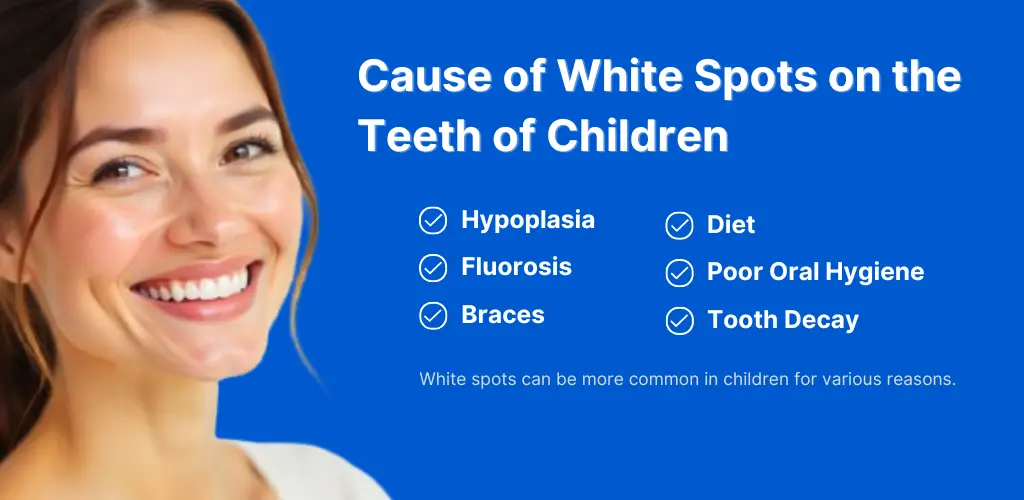
Hypoplasia
Hypoplasia or enamel hypoplasia is a dental condition wherein tooth enamel doesn’t develop properly. The greatest causes of this are nutritional deficiencies, genetic conditions, or illness.
Signs of enamel hypoplasia are discoloration of teeth, pits, grooves, or greater vulnerability to tooth decay.
Treatment options for this condition include fluoride treatments and restorative procedures such as sealants and composite fillings.
Fluorosis
Fluoride is a beneficial mineral for dental health. However, in rare cases when children have too much, it can damage their teeth.
Excessive fluoride can lead to underdeveloped teeth and tooth decay, presented as white spots. Speaking with your dentist can shed light on the ideal amount of fluoride to consume.
Braces
Braces naturally make it harder to clean your teeth. Using floss to clean them efficiently also becomes a struggle. This makes frequent dentist visits a necessary action to maintain oral hygiene.
In such cases, parents should take their child to the dentist more frequently. Professional cleaning will allow the removal of plaque and tartar in hard-to-reach places.
Diet
A diet low in dairy and fresh foods can stunt or interfere with normal tooth development. Children will face shortages of calcium and have smaller or less hardy enamel. This highlights the vital nature of a balanced diet for children.
Calcium and phosphate-rich diets are essential for repairing tooth enamel regularly.
Poor Oral Hygiene
Children may not be following the correct oral care guide, as they could be ignoring nighttime brushing. Also, teenagers with braces may not be brushing effectively around these appliances. Both instances can lead to the formation of white spots on teeth.
Tooth Decay
There is a significant chance that the white spots on kids’ teeth are just tooth decay. The appearance of white areas on the teeth signifies decaying tooth mat
Conclusion
The severe presence of white spots on teeth can leave an unwanted sight, causing you to smile less. It could also lead to extreme tooth decay, affecting your ability to eat or drink normally without pain.
What’s worse is that this chalky-white appearance could be a sign of disease. Getting your teeth checked at 65 Broadway Dental can rule out the causes and deliver effective corrective treatments.
FAQs
1. What’s the best way to get rid of white spots on teeth?
Getting rid of white spots on teeth starts by identifying the cause behind them. Most dental treatments for white spots include fluoride treatments, dental cleaning, teeth whitening, porcelain veneers, ICON, and microabrasion.
2. Will white spots on teeth go away?
The cause and severity of the spots determine if they are temporary or permanent. A temporary status means they are removable and can go away.
3. Are white spots on teeth a cavity?
White spots on teeth may be an early sign of tooth decay. It’s the leading reason why children may develop white spots on their teeth.
4. What are the early signs of tooth decay?
Tooth decay can present in various signs, and white spots appearing on teeth are one of them.
5. What do white dots on my teeth mean?
White dots on teeth can be an indication of fluoride issues, diet deficiencies, enamel hypoplasia, or poor oral hygiene.

Dr. Alexander Heifitz (Author)
Dr. Alexander Heifitz is the founder of 65 Broadway Dental in NYC, where he combines advanced dental expertise with a patient-first approach. He specializes in cosmetic and restorative treatments such as dental implants, veneers, Invisalign, and smile makeovers, helping New Yorkers achieve both oral health and confidence.
Booking An Appointment
Looking for a reliable dentist in Downtown NYC? Whether you need a routine cleaning, urgent care, or a full smile transformation — we’ve got you covered. We accept most PPO insurance plans and offer flexible scheduling.
+1 (212) 430-3888
Call for appointment
Walk-ins Welcome / Same-Day Appointments Available

Related Blogs

Understanding Sleep Apnea: Symptoms, Causes & How to Treat It
It’s a device placed between the teeth that prevents the jaw from retracting when sleeping. This keeps the upper airway more open so
Read More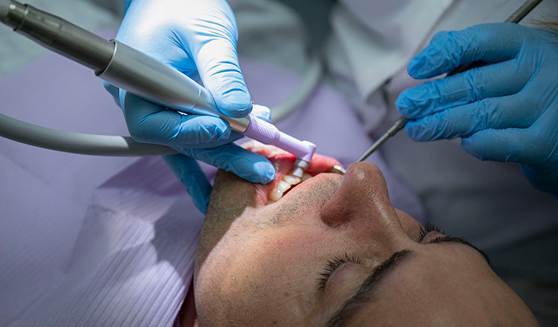
TMJ Treatment in NYC: Symptoms, Costs, Exercises, Surgery & Newest Relief Options
Temporomandibular joint disorders, often called TMJ, occur as a result of problems with the jaw, jaw joint, and surrounding facial muscles that control
Read More